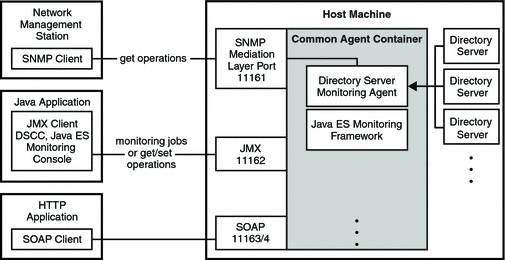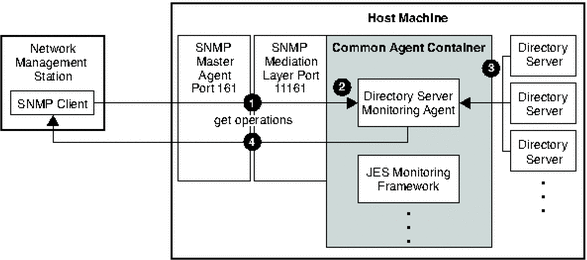Directory Server and SNMP
Directory Server implements the dsTable and the dsApplIfOpsTable of the Directory Server Monitoring MIB defined by RFC 2605. It does not implement the dsIntTable.
Directory Server also implements the Network Services Monitoring MIB defined by RFC 2788.
Directory Server support for SNMP has the following limitations.
-
SNMP support is for monitoring only, no SNMP management is supported.
-
No SNMP traps are implemented.
This rest of this section explains how the information flows from the monitoring application to Directory Server and back, particularly in the case where you use SNMP.
The SNMP interface is exposed by Java ES MF. See the Sun Java Enterprise System 5 Update 1 Monitoring Guide for details.
The monitoring framework is contained within the Common Agent Container, cacao, which is installed alongside Directory Server. Figure 6–1 shows the monitoring framework.
Figure 6–1 Overall Monitoring Information Flow

SNMP support for monitoring Directory Server is managed by a Directory Server agent in the Common Agent Container. On Directory Server startup, the Monitoring server plug-in registers theDirectory Server instance with the Directory Server agent within the Common Agent Container.
Figure 6–2 shows how SNMP information about Directory Server flows through the Common Agent Container.
Figure 6–2 SNMP Information Flow

-
The network management station sends a GET message through the master SNMP agent, which by default uses standard port 161, to the SNMP mediation layer, which by default uses port 11161.
For information about how to configure access to the SNMP mediation layer, see the Sun Java Enterprise System 5 Update 1 Monitoring Guide.
-
The SNMP mediation layer forwards any requests destined for the Directory Server to the Directory Server agent.
-
When the server state changes, Directory Server pushes SNMP information to the Directory Server agent.
-
The Directory Server agent relays the response back to the SNMP client via the SNMP mediation layer and master SNMP agent to the network management station. The network management station then displays the data through its network management application.
SNMP information about Directory Server flows as follows.
- © 2010, Oracle Corporation and/or its affiliates
